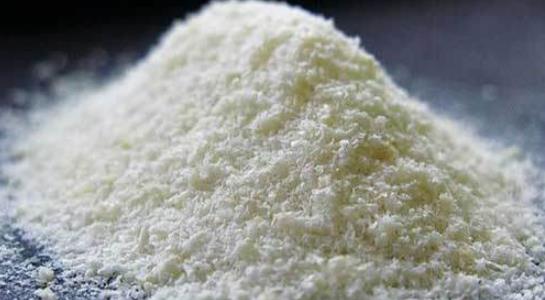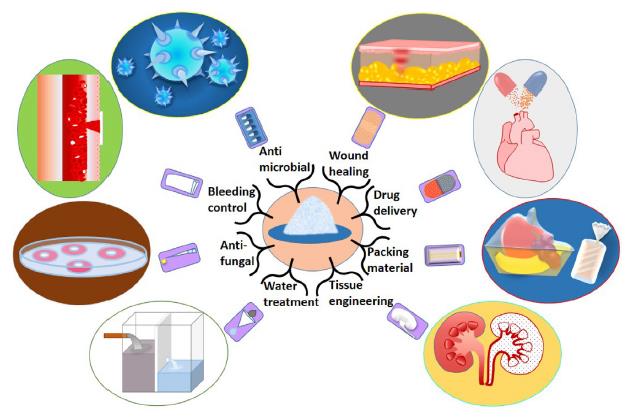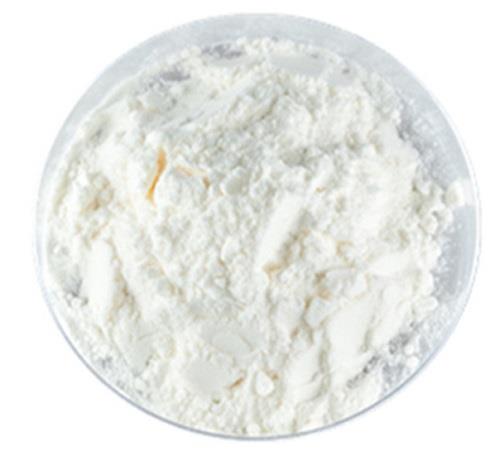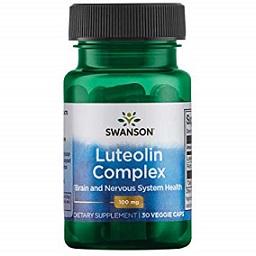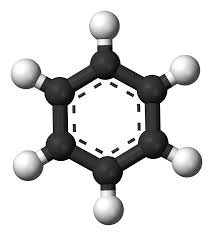Applications of Chitosan
Chitosan is a linear polymer formed by D-glucosamine and N-acetyl-D-glucosamine. This biopolymer and its derivatives are considered promoters of diverse biological activities, including antioxidant, antihypertensive, antiinflammatory, anticoagulant, antitumoral, antimicrobial, hypocholesterolemic, and antidiabetic effects.
Chitosan is a linear polysaccharide composed of randomly distributed β-(1→4)-linked D-glucosamine (deacetylated unit) and N-acetyl-D-glucosamine (acetylated unit). Chitosan is found naturally in the cell walls of some fungi. However, this polymer is obtained industrially by deacetylation of chitin, which is extracted from the exoskeletons generated by crustacean-processing plants from animals such as shrimp, lobsters, crabs, and krill. Chitin is associated with proteins, minerals, lipids, and pigments. The chemical purification of chitin from crustaceans involves two processes. Initially, the wastes are demineralized to remove inorganic matter by applying dilute hydrochloric acid (HCl) and then deproteinized in a dilute aqueous solution of sodium hydroxide (NaOH) or (potassium hydroxide) KOH. Chitin can be converted to chitosan by chemical or enzymatic methods and both processes are based on the deacetylation of chitin. Deacetylation is the process of converting chitin to chitosan by removing acetyl groups from N-acetylglucosamine to form D-glucosamine units, which contain free amino groups and increase the solubility of the polymer in aqueous media [2].

Jamnongkan and Kaewepirom (2010) point out that chitosan is a biopolymer that behaves like a hydrogel because its three-dimensional structure can absorb and retain high amounts of water, allowing it to swell without the need to completely dissolve. Because its hydroxyl groups and other active sites are capable of strongly interacting with water and various organic molecules, allowing their application in areas such as agriculture, medicine, and the production of industrial materials. Chitosan is used for obesity, high cholesterol, high blood pressure, and Crohn disease.
In body weight reduction, despite the many studies, the mechanism of action of chitosan has not been completely established. It is known that in the acidic environment of the stomach, chitosan acts as a soluble fiber and can increase its volume given its water absorption capacity. After this, in the nonacidic environment of the small intestine, chitosan becomes insoluble and forms a gel that encapsulates dietary fats. This insoluble complex travels through the large intestine and is naturally eliminated (Kaats et al., 2006). Additionally, it has been proposed that the positive charges of chitosan attract negatively charged molecules such as lipids and biliary salts (Elsabee et al., 2009).
Clinical studies on the use of chitosan as a dietary supplement for its antioxidative activity are insufficient. The effect of chitosan as an antioxidant has mainly been studied on laboratory animals such as rats (Anandan et al., 2013; Anraku et al., 2010; Yoon et al., 2008), prawns, dogs, and cats. There are also in vitro trials where the antioxidant activity has been measured by the reducing power and radical scavenging activity of chitosan (Hajji et al., 2015; Yen et al., 2007) [3].
Chitosan is also used for issues caused by kidney failure, including high cholesterol, "tired blood" (anemia), loss of strength and appetite, high phosphorous levels (hyperphosphatemia), and trouble sleeping (insomnia). Some people apply chitosan directly to their gums for inflammation that can lead to tooth loss (periodontitis), or chew gum that contains chitosan to prevent "cavities" (dental caries). It is also used in the eyes to treat dry eyes. In an effort to help "donor tissue" rebuild itself, plastic surgeons sometimes apply chitosan directly to places from which they have taken tissue to be used elsewhere. Chitosan is also used to stop bleeding after some surgeries. In pharmaceutical manufacturing, chitosan is used as a filler in tablets, to improve the way certain drugs dissolve, and to mask bitter tastes. It is also used to help make foods last longer.
The agricultural and horticultural uses for chitosan, primarily for plant defense and yield increase, are based on how this glucosamine polymer influences the biochemistry and molecular biology of the plant cell. The cellular targets are the plasma membrane and nuclear chromatin. Subsequent changes occur in cell membranes, chromatin, DNA, calcium, MAP Kinase, oxidative burst, reactive oxygen species, callose pathogenesis-related (PR) genes and phytoalexins [4]. Chitosan is typically used as a natural seed treatment and plant growth enhancer, and as an ecologically friendly biopesticide substance that boosts the innate ability of plants to defend themselves against fungal infections [1,5].
References
[1] https://en.wikipedia.org/wiki/Chitosan.
[2] T. Phililibert, B. H. Lee, N. Fabien, Current status and new perspectives on chitin and chitosan as functional biopolymers. Appl. Biochem. Biotechnol., 2017, 181, 1314–1337.
[3] Dalia I. Sánchez-Machado, Jaime López-Cervantes, Ma. A. Correa-Murrieta, Reyna G. Sánchez-Duarte, Paola Cruz-Flores and Gabriela Servín de la Mora-López, Chitosan. Nonvitamin and Nonmineral Nutritional Supplements. https://doi.org/10.1016/B978-0-12-812491-8.00064-3.
[4] L. A. Hadwiger, Multiple effects of chitosan on plant systems: Solid science or hype. Plant Science, 2013, 208: 42–49.
[5] J. C. Linden, R. J. Stoner, K. W. Knutson, C. A. Gardner-Hughes, Organic disease control elicitors. Agro Food Industry Hi-Tech., 2000,11 (5): 32–34.
You may like
Related articles And Qustion
Lastest Price from Chitosan manufacturers
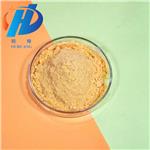
US $3.00/kg2024-04-19
- CAS:
- 9012-76-4
- Min. Order:
- 1kg
- Purity:
- 99.92%
- Supply Ability:
- 50000tons
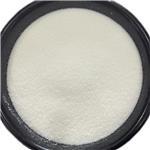
US $6.00/KG2024-04-19
- CAS:
- 9012-76-4
- Min. Order:
- 1KG
- Purity:
- More than 99%
- Supply Ability:
- 2000KG/MONTH

